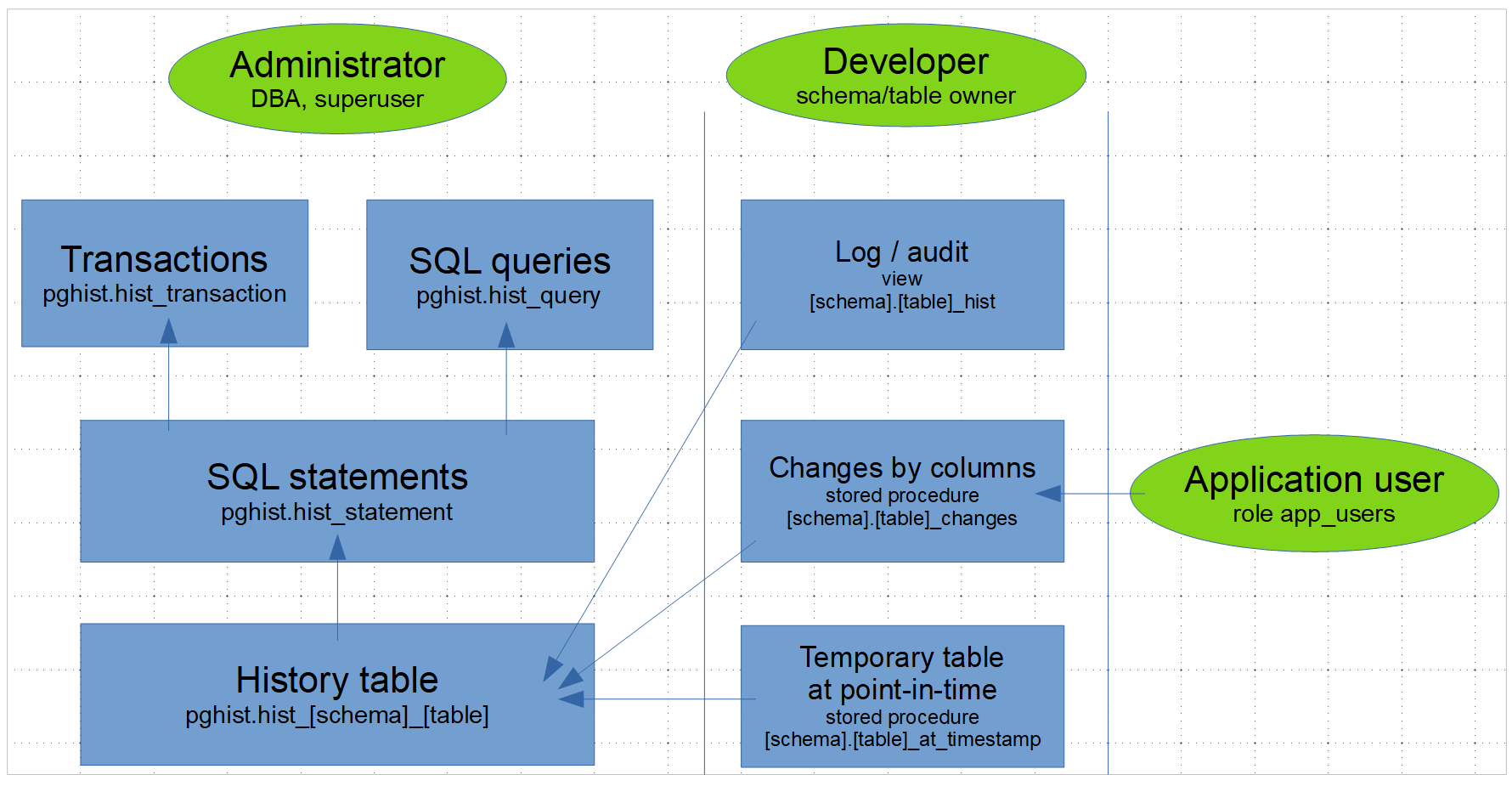Description
Tool PGHIST keeps history of table changes and allows to get log(audit) of changes by row, list of changes by field indicating user, time of the change, SQL query, transaction, other technical information and table as of date-time in the past (versioning). To display information in user interface, SQL expressions are defined to describe changed table rows and fields. It is possible to override the operation name and username functions.
Design and working principle
PGHIST is a schema with procedures and common tables: transactions, SQL expressions. When history is enabled (procedure pghist.hist_enable), for specified table created additional table, triggers for insert,update,delete,truncate, stored procedures and view for obtaining data. When a table is changed, triggers are fired that modify the history table. There are also event triggers that rebuild the history table and recreate the stored procedures.
Main functions and view
| pghist.hist_enable([schema],[table]) | - | enable history keeping |
| [schema].[table]_hist | - | log(audit) of changes by row, optimized for analysis |
| [schema].[table]_changes | - | list of changes by field, optimized for display to the user |
| [schema].[table]_at_timestamp | - | table at date-time in the past (versioning) |
More details on page Documentation
-- Create table create table example( id int primary key, name varchar(20), number numeric(10,2), date date ); -- Enable keeping history call pghist.hist_enable('example'); -- Change data insert into example values (1, 'Example', 10, current_date); update example set number=20, date=date-1; -- View change log by row select * from example_hist; -- View changes by field select * from example_changes() order by 1,2,3; -- View table at timestamp select * from example_at_timestamp(now()-interval '10 second'); -- drop table example cascade;
- Storage optimization - saving only old values of changed fields and primary key. The Transaction-Expression-Row storage structure matches the operation of the DBMS and minimizes redundancy.
- Versatility - possible to get change log, list of only changed data from several tables and table at a point in time
- Descriptions - for each table and its columns, it is possible to define SQL expressions to describe changed rows and field values. By default, descriptions are created for foreign key fields and table rows
- Inheritance - stored procedures have parameter "cascade" that allows you to get data with or without inheritance
- Transaction and SQL statements - changes have a reference to SQL statements, that references a transaction. Can get all the changes made within a single transaction or rows within one expression
- Indexes - for a history table, an index is built on the primary key column(s), for a table at a point in time - standard indexes on columns
- Condition (optional) - when getting a list of changes, you can specify a condition with or without parameter
- Autocorrection - when performing DDL operations on a table (alter table, create index, etc.), a trigger fires, that corrects the history keeping. When a table is deleted, its history is also deleted
- Extended names - expanded (in double quotes) table and column names are supported

- Update primary key values - updating the values of primary key columns is not supported (exception will be raised)
- Recreate view - when a column is dropped or changed, the view [schema].[table]_hist is dropped and created again (PostgreSQL support only add columns to a view), recommended to create a stored function(wrapper) with a dynamic query
- Significant table changes - when the table is significantly changed (for example, reassigning the primary key to another field), the history table may be incorrectly rebuilded, recommended to remove and create history again (pghist.hist_disable and pghist.hist_enable)
Review posted on Youtube


